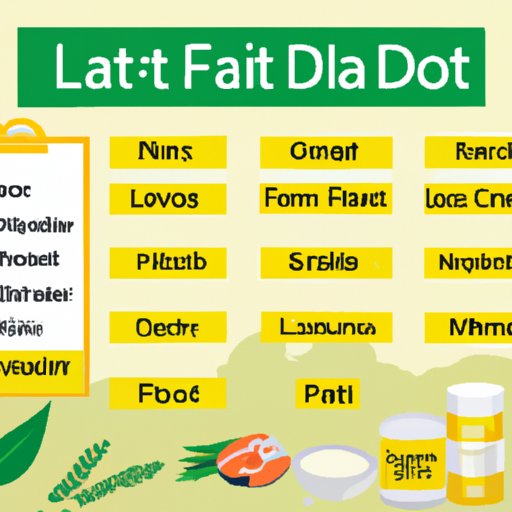Introduction
A low-fat diet is one that limits the amount of fat you consume. It typically includes eliminating or reducing foods that are high in saturated and trans fats and focusing on foods that are lower in fat and higher in fiber. Following a low-fat diet can help you lose weight, improve your cholesterol levels, and reduce your risk for chronic diseases such as heart disease and diabetes.
Create a Meal Plan that Highlights Low-Fat Foods
Creating a meal plan is an important part of following a low-fat diet. You’ll want to focus on eating foods that are low in fat and high in fiber and protein. Start by making a list of healthy, low-fat foods that you enjoy eating. This list should include fruits, vegetables, whole grains, lean proteins, and low-fat dairy products. Once you have your list, you can start planning meals and snacks around these foods.
For example, you could have oatmeal with berries and nuts for breakfast, a salad with grilled chicken for lunch, and roasted vegetables with baked salmon for dinner. In between meals, you can snack on fresh fruit, hummus and veggies, or yogurt with granola. These are just a few examples of meals and snacks you can incorporate into your low-fat diet.
Learn to Read Labels and Identify Low-Fat Foods
Reading food labels is an important part of following a low-fat diet. You’ll want to look for foods that are low in fat, saturated fat, and trans fat. Examples of low-fat foods include skinless chicken breasts, fish, tofu, beans, legumes, nonfat or low-fat dairy products, and reduced-fat peanut butter. When shopping for packaged foods, be sure to check the nutrition label for the amount of fat per serving.
It’s also important to be aware of hidden sources of fat. Many processed foods, such as crackers, chips, and cookies, contain trans fats. Trans fats can increase your risk of heart disease, so it’s best to avoid them altogether. Stick to whole, unprocessed foods for the healthiest options.

Incorporate Healthy Fats into Your Diet
It’s important to note that not all fats are bad for you. There are some healthy fats that you can incorporate into your low-fat diet. Healthy fats include monounsaturated fats (such as olive oil and avocados) and polyunsaturated fats (such as nuts, seeds, and fish). These fats can help lower bad cholesterol levels and reduce your risk of heart disease.
When using healthy fats, it’s important to be mindful of portion sizes. Even healthy fats are high in calories, so it’s best to limit your intake to 1-2 tablespoons per day. You can add healthy fats to salads, stir-fries, and other dishes to give them more flavor.
Choose Lean Protein Sources
Protein is an important part of any diet, including a low-fat diet. The key is to choose lean sources of protein, such as skinless chicken breasts, fish, tofu, legumes, and eggs. These foods are low in fat and high in protein, which will help keep you full and satisfied throughout the day.
In addition to providing protein, lean proteins also provide essential vitamins and minerals. For example, fish is a good source of omega-3 fatty acids, which are important for heart health. Eggs are rich in B vitamins, which are essential for energy production. Choosing lean proteins can help ensure that you get enough of these essential nutrients.
Eat More High-Fiber Foods
High-fiber foods are an important part of any diet, but they are especially beneficial for those following a low-fat diet. Fiber helps fill you up without adding extra calories, so it can be beneficial for weight loss. It can also help lower cholesterol levels and reduce your risk of certain diseases.
Examples of high-fiber foods include whole grains, fruits and vegetables, legumes, and nuts and seeds. Be sure to read food labels to make sure you’re getting enough fiber per serving. Aim for at least 25 grams of fiber per day for optimal health.
Stock Up on Low-Fat Dairy Products
Low-fat dairy products can also be incorporated into a low-fat diet. These products are lower in fat than their full-fat counterparts, but still provide the same amount of calcium and protein. Examples of low-fat dairy products include nonfat or low-fat milk, yogurt, cheese, and cottage cheese.
When choosing dairy products, be sure to read the nutrition label. Some products may still be high in sugar even if they are low in fat. Opt for unsweetened varieties or those that are sweetened with natural sweeteners such as honey or maple syrup.
Add Flavor with Herbs and Spices
Herbs and spices can be used to add flavor to low-fat meals without adding extra fat or calories. These flavorful ingredients can also help boost the nutrient content of your meals. For example, oregano is a good source of antioxidants, while cinnamon is thought to help regulate blood sugar levels.
You can use herbs and spices to liven up salads, soups, and other dishes. Popular spices include turmeric, cumin, ginger, garlic, and paprika. Fresh or dried herbs such as basil, parsley, rosemary, and thyme can also be used to enhance the flavor of your meals.
Conclusion
Following a low-fat diet can help you lose weight, improve your cholesterol levels, and reduce your risk for chronic diseases. To do this, focus on eating foods that are low in fat and high in fiber and protein. Incorporate healthy fats, lean proteins, high-fiber foods, and low-fat dairy products into your diet. And don’t forget to add flavor with herbs and spices.
By following these tips, you can create a balanced, nutritious diet that is low in fat and full of flavor. With a little planning and preparation, you can easily follow a low-fat diet and reap the health benefits.
(Note: Is this article not meeting your expectations? Do you have knowledge or insights to share? Unlock new opportunities and expand your reach by joining our authors team. Click Registration to join us and share your expertise with our readers.)
